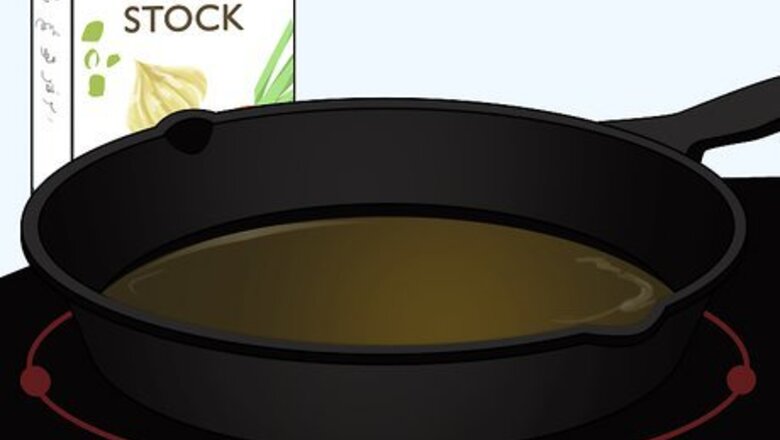
views
- Cook leftover risotto on the stove with butter over medium heat for 5-10 minutes.
- Heat your leftover risotto in the microwave for about 3 minutes, stirring occasionally.
- Bake your leftover risotto in the oven at 350 °F (177 °C) for 10 minutes, or form it into balls coated in flour, egg, and breadcrumbs and bake the same way for delicious arancini.
- Freeze leftover risotto for up to 3 weeks, and refrigerate leftover risotto for up to 4 days.
Stove
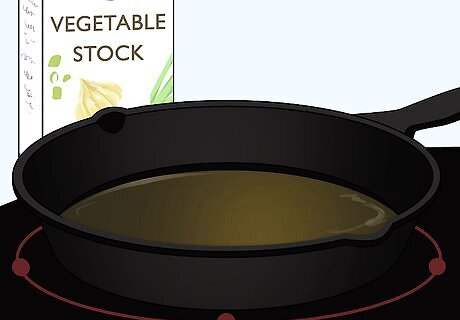
Add 2–3 tablespoons (30–44 mL) of stock to a pan over medium heat. Add low-sodium chicken or vegetable stock to a cold nonstick or cast-iron pan, and let it warm up until it’s steaming just slightly. The stock will help put some moisture back into the dish so that it’s just as creamy and moist as the first time. Substitute water for stock for even lower sodium, or if you don’t have stock on-hand.

Add the leftover risotto to the pan and cook it for 5-10 minutes. Stir the risotto continuously so that it doesn’t stick to the pan and burn. Add more stock about 1 tablespoon (15 mL) at a time if the risotto looks dry. Additionally, add 1 teaspoon (4.9 mL) of white cooking wine to add extra depth to your leftover risotto.
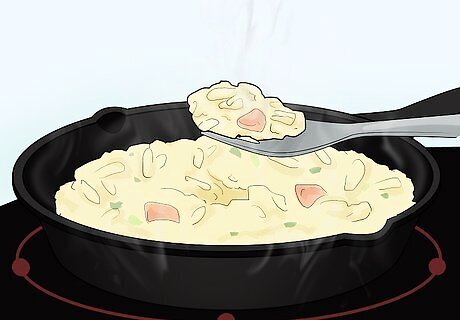
Test to make sure the risotto has been thoroughly reheated, then serve it. When the risotto begins to steam (after about 5-10 minutes), use a fork or spoon to sample a small amount from the center of the pan. Note if the risotto has been heated all the way through. If it’s hot enough for your taste, remove the risotto from the heat and serve it. After serving, season your leftover risotto with salt or MSG to bring out extra flavor.
Microwave
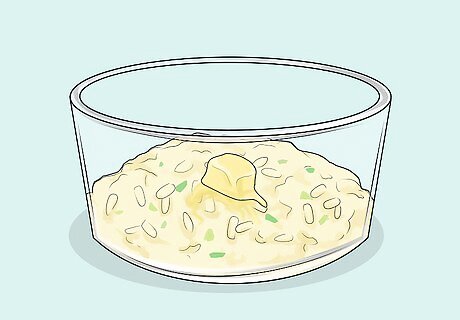
Place your leftover risotto in a microwave-safe dish with 1 tbsp (0.5 oz) of butter or stock. Use a glass, plastic, or other microwave-safe container. Don’t use metal or aluminum containers in a microwave. You can also add 1 teaspoon (4.9 mL) of white cooking wine to add an extra layer of flavor to your microwaved risotto. Make sure all plastic containers are rated as safe for microwave use by the manufacturer.
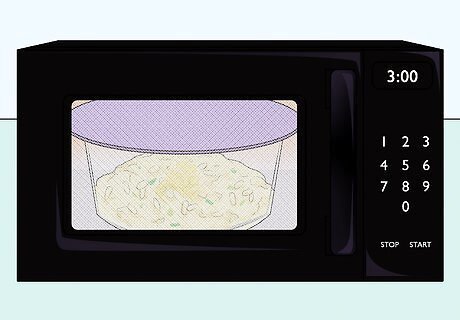
Cover and heat the risotto for 3 minutes on high power. To prevent a mess, cover the risotto with a paper towel or a loosely positioned lid (don’t secure it to the container). Every 30-60 seconds, stop the microwave and stir the risotto to ensure even heating.

Let the risotto sit for a minute, then serve it. This will let the risotto cool to a comfortable temperature for eating, as well as let the colder area of the risotto absorb more heat. Then, use oven mitts to remove the container from the microwave, and enjoy your risotto.
Oven
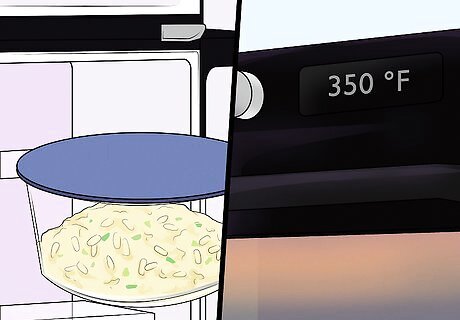
Remove your risotto from the fridge and preheat your oven to 350 °F (177 °C). Give your oven about 20 minutes to preheat. Meanwhile, take your risotto out of the fridge and place it on a counter to allow it to come to room temperature before you place it in the oven, which will allow it to heat more evenly.

Place the risotto in a buttered dish with 2–3 tablespoons (30–44 mL) of stock. Then, spread the risotto across the bottom of the pan, and sprinkle chicken or vegetable stock evenly over the top. Add additional stock if the risotto has dried out. Additionally, you can add 2–3 tablespoons (30–44 mL) of white cooking wine for more depth of flavor.
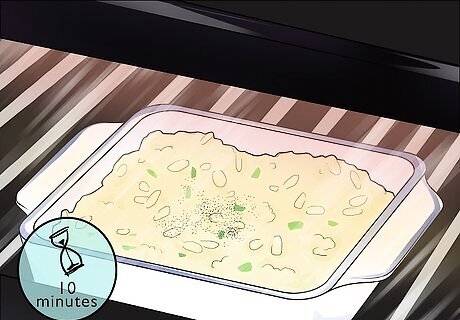
Bake the risotto in the oven for 10 to 30 minutes until warmed throughout. Use oven mitts to place the risotto on the center rack of the oven, and set a timer for 10 minutes. Every 2 minutes or so, remove the risotto from the oven and stir it to evenly distribute the heat, then place the risotto back in the oven. If the risotto appears dry, add 1–2 tablespoons (15–30 mL) of chicken stock as you stir the risotto.

Remove the risotto from the oven. Use oven mitts to remove the risotto from the oven, and let it sit for a while to cool. After about 5 minutes, portion the risotto into dishes and serve it.
Steaming
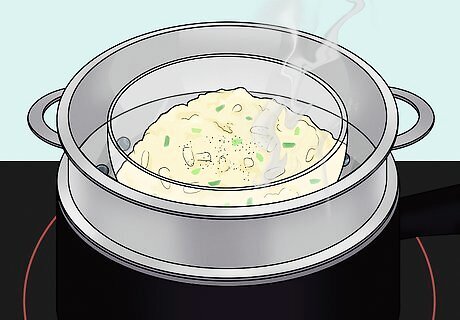
Bring a pot of water to a boil and place the risotto in a steamer basket on top. Use about 4 cups (0.95 L) of water. Then, position the basket so that its bottom is above the boiling water, to make sure your risotto doesn’t get soggy or wet.
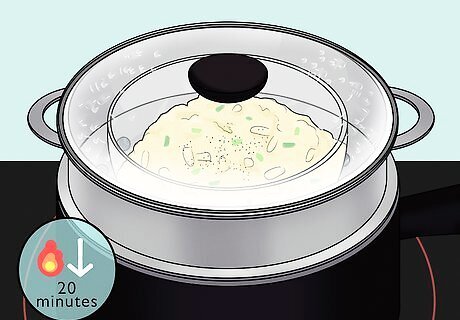
Cover the steamer basket and reduce the stove heat to low for about 20 minutes. This technique takes the longest, so after the 20 minutes are over, use a food thermometer to check and make sure the risotto has been heated to at least 165 °F (74 °C). If it hasn’t, cover it again and cook for another 10 minutes, or until it reaches the target temperature.
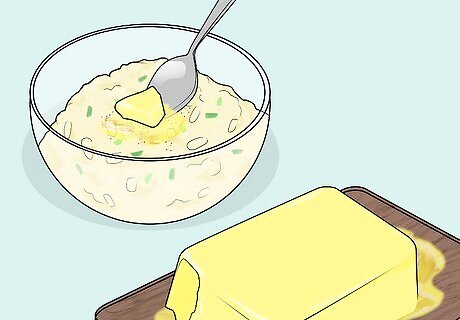
Remove the risotto from the steamer and add 1 tbsp (0.5 oz) of butter. Mix the butter into the risotto thoroughly, so that it melts and is evenly distributed. Then, spoon the risotto onto a plate and enjoy. Optionally, add a splash of white cooking wine to reintroduce some flavor to your risotto.
Freezing and Storing

Store cooled risotto in airtight plastic or pyrex containers. After you’ve cooked your risotto, let it cool completely, for about 2 hours. Then, transfer it from the cookware into a freezer or fridge-safe container, like a Tupperware, and seal the container. Make sure the container is airtight to prevent the formation of bacteria.
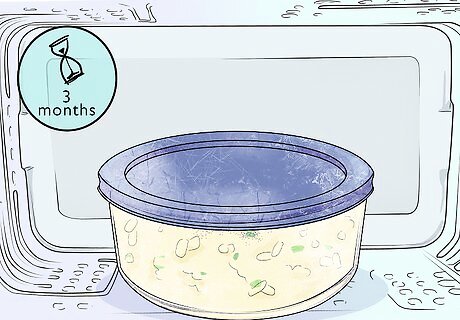
Place your risotto in a freezer and store it for up to 3 months. You can store it for a few months longer than that if you like, but 3 months is the sweet spot. Within this period, the risotto will retain enough flavor and texture to make it nice and tasty when you reheat it. Any longer, and the quality of the dish will begin to degrade. Alternatively, you can place your risotto in the fridge and store it there for up to 4 days.
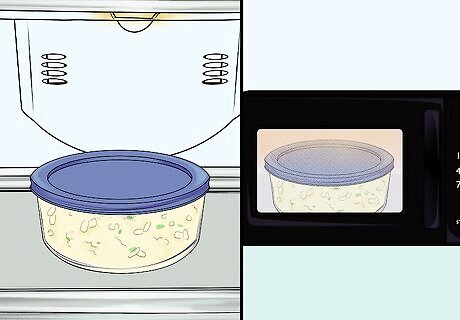
Defrost your frozen risotto in the fridge overnight, or in the microwave. The night before you plan to reheat your risotto, move it from the freezer to the fridge, to allow the risotto to thaw safely, with minimal risk of bacterial formation. Or, quickly defrost your risotto by microwaving it on full power for about 5 minutes. Then, use an above method to reheat it thoroughly. It’s not recommended that you refreeze your risotto after freezing it a first time. This significantly increases the risk of food-borne illnesses.




















Comments
0 comment